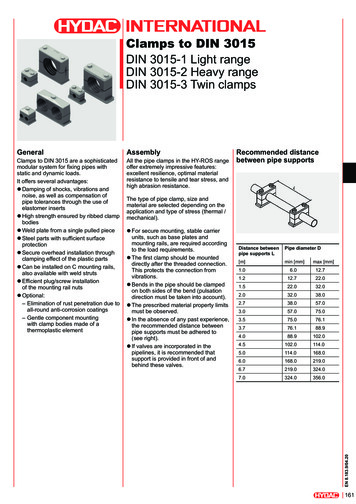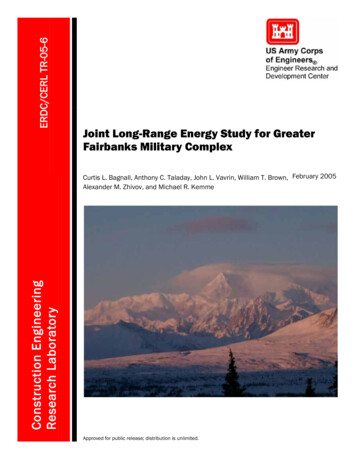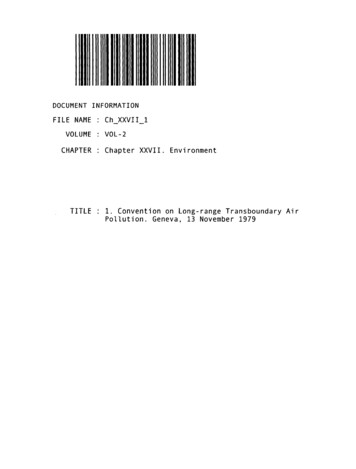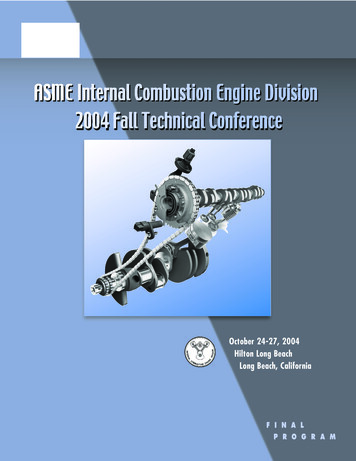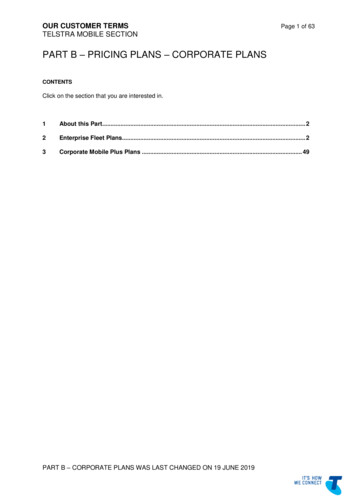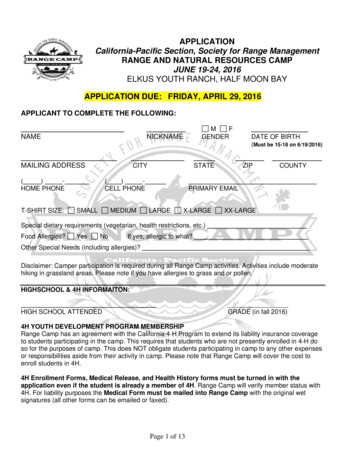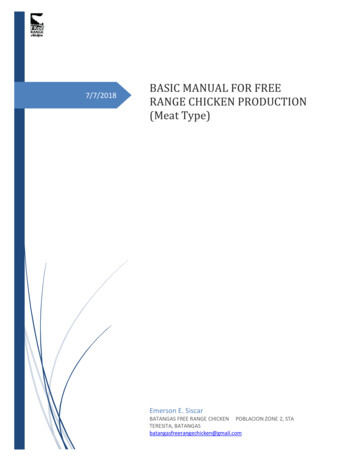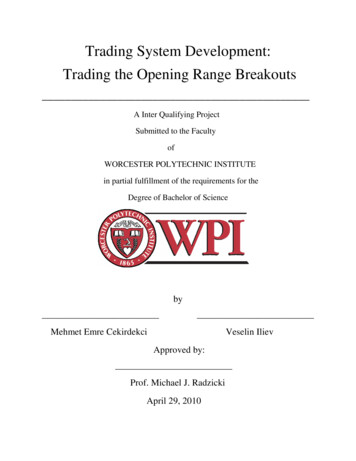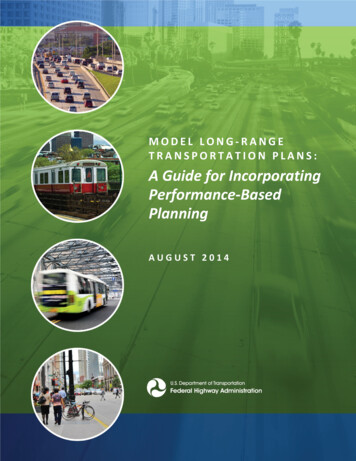
Transcription
MODEL LONG-RANGETRANSPORTATION PLANS:A Guide for IncorporatingPerformance-BasedPlanningAUGUST 2014
Technical Report Documentation Page1. Report No.FHWA-HEP-14-0462. Government Accession No.3. Recipient’s Catalog No.4. Title and SubtitleModel Long Range Transportation Plans:5. Report DateAugust 2014A Guide for Incorporating Performance-Based Planning6. Performing Organization Code7. Authors8. Performing Organization ReportNo.Michael Grant (ICF), Alanna McKeeman (ICF), Beverly Bowen (ICF),Alexander Bond (ICF), Jocelyn Bauer (Leidos), Linda LaSut (Leidos), BrentBarnes (ICF), Janet D’Ignazio (ICF)10. Work Unit No. (TRAIS)9. Performing Organization Name and AddressICF International9300 Lee HighwayFairfax, VA 2203111. Contract or Grant No.DTFH61-12-C-00021Leidos11251 Rodger Bacon DriveReston, VA 2019013. Type of Report and PeriodCoveredSeptember 2012 – June 201412. Sponsoring Agency Name and AddressUnited States Department of TransportationFederal Highway Administration1200 New Jersey Ave. SEWashington, DC 2059014. Sponsoring Agency CodeHEPP15. Supplementary NotesMs. Jody McCullough, Federal Highway Administration, COTM16. AbstractThis Guidebook informs State departments of transportation (DOTs), metropolitan planning organizations (MPOs), andregional transportation planning organizations (RTPOs), as well as their planning partners such as transit agencies, localgovernments, and Federal agencies, about effective practices for incorporating performance-based planning into thedevelopment of a long range transportation plan. A performance-based plan sets the foundation of goals, objectives,performance measures, and targets that support decisions for long-range investments and policies, and guidesprogramming, as well as shorter-range decisions that move toward achievement of desired system performanceoutcomes. This document identifies key components present in a “model” transportation plan, as well as processelements that are necessary to reflect the priorities of the community and support attainment of desired performanceoutcomes for the multimodal transportation system. Examples and case studies illustrate the Guide’s key points.17. Key WordsTransportation planning, metropolitan planning, statewideplanning, nonmetropolitan planning, long range,performance, targets, measures, objectives, baseline, public,stakeholder, multimodal, scenarios, programming19. Security Classif. (of this report)Unclassified18. Distribution StatementNo restrictions. This document is available to the publicfrom the National Technical Information Service,Springfield, VA 22161.20. Security Classif. (of this page)Unclassified21. No. of Pages17622. PriceN/AForm DOT F 1700.7 (8-72) Reproduction of completed page authorizedMODEL LONG-RANGE TRANSPORTATION PLANS: A Guide for Incorporating Performance-Based Planningi
Table of ContentsAgencies Index – Notable Practices . vii1.Introduction . 1Guidebook Purpose . 2Background . 3Organization of Guidebook . 52.Overview: Developing a Performance-Based Transportation Plan . 7Key Elements of a Performance-based Transportation Plan . 7Formats for Performance-based Transportation Plans.16Process of Developing a Performance-based Transportation Plan.193.Public and Stakeholder Participation and Agency Collaboration . 24Engagement in a Performance-based Plan .25Public and Stakeholder Participation .27Interagency Consultation and Coordination .38Carrying Engagement Through to Implementation .404.Scoping and Baseline Information . 41Description of Multimodal Transportation System .41Information on Existing Conditions and Trends .42Future Challenges and Risks .44Revenue Projections .47Consideration of Applicable Planning Studies, Policies, Performance-based Plans .475.Strategic Vision, Goals and Objectives. 49Developing a Vision .49Goals and Objectives: Definitions .50MODEL LONG-RANGE TRANSPORTATION PLANS: A Guide for Incorporating Performance-Based Planningii
Linking Transportation Plan Goals and Objectives to Broader Plans .586.Performance Measures and Targets . 60Key Roles for Performance Measures in the Transportation Plan.61Identifying, Selecting, and Implementing Performance Measures for the Plan .67Identifying Desired Trends or Targets.757.Transportation System Performance Report . 81Comparing Trends to Targets .81Examples: Within and Outside of the Transportation Plan .828.Identification of System Needs, Potential Strategies, and Costs . 87Performance Needs Assessment .87Financial Planning.89Identification of Possible Solutions and their Costs .919.Investment Analysis and Selection . 102Scenario Analysis to Compare Alternative Investment Strategies . 102Using Performance Information to Support Project Prioritization and Selection of aPreferred Alternative. 10810. Connecting the Transportation Plan and Programming . 111Connection with the TIP and STIP and Project Prioritization . 111Support for Project Development . 114Planning Studies . 114Future Directions and Planning Cycles. 11511. Case Studies . 116Case Study: Arizona Department of Transportation - What Moves You Arizona: 20102035 Long-Range Transportation Plan . 116Case Study: Metropolitan Transportation Commission (MTC), San Francisco Bay Area– Plan Bay Area . 121MODEL LONG-RANGE TRANSPORTATION PLANS: A Guide for Incorporating Performance-Based Planningiii
Case Study: Michigan Department of Transportation – 2035 Long RangeTransportation Plan . 132Case Study: Pikes Peak Area Council of Governments – Moving Forward Update 2035144North Central Pennsylvania Planning and Development Commission: Case Study onConnecting Planning and Project Prioritization. 153Appendix: Federal Requirements for Transportation Plans . 158Metropolitan Transportation Plan . 158Statewide Transportation Plan . 165Resources. 172FHWA/FTA Transportation Planning Resources . 172Federal Resources on Data and Tools . 174Other Resources . 175MODEL LONG-RANGE TRANSPORTATION PLANS: A Guide for Incorporating Performance-Based Planningiv
List of FiguresFigure 2-1. Framework for PBPP . 8Figure 2-2: MnDOT Family of Plans . 17Figure 2-3: Connections between MTP, CTP, and AR in Maryland . 18Figure 2-4: Arizona Plan Development Process: Building Blocks . 22Figure 3-1. Sample Outcomes from DVRPC Choices and Voices Tool . 32Figure 6-1. Pike’s Peak Area Council of Governments – 2035 Moving Forward Update to the RegionalTransportation Plan . 63Figure 6-2. A Subset of Performance Measures included in the Southern California Association ofGovernments’ 2012-2035 RTP . 65Figure 6-3. Proposed California MPO Performance Measures . 71Figure 6-4. Genesee Transportation Council – LRTP 2035 Performance Measures . 77Figure 6-5. CMAP Examples of Targets in Go To 2040 Plan . 78Figure 7-1. Safety Performance Results from 2002 Maryland DOT Attainment Report . 82Figure 7-2. Safety Performance Results from 2013 Maryland DOT Attainment Report . 83Figure 7-3. PeMS System Report Used by MPOs in California . 84Figure 7-4. Champaign-Urbana Annual Performance Report Card Excerpt . 85Figure 7-5. Sample Chart from UDOT’s Strategic Direction and Performance Measures Report . 86Figure 9-1. Arizona 2035 Long Range Transportation Alterantive Investment Choices (AIC) “Grades” . 103Figure 9-2. Minnesota Department of Transportation: Using Scenarios to Link Management Systems tothe LRTP . 104Figure 9-3. Minnesota Department of Transportation: Final MnSHIP Investment Priorities . 105Figure 9-4. Graphical depiction of Scenario 1 from SCAG’s Transportation Plan Development Process . 106Figure 9-5. Colorado LRTP Presentation of Alternative Investment Scenarios . 108MODEL LONG-RANGE TRANSPORTATION PLANS: A Guide for Incorporating Performance-Based Planningv
Figure 9-6. Metropolitan Transportation Commission: Project Performance Assessment . 110Figure 11-1: Project Performance Assessment Results, incorporating Support for Targets and Benefit/Cost. 127Figure 11-2: Plan Bay Area Process and Timeline . 129Figure 11-3: Michigan DOT Performance Measure Development Process . 136Figure 11-4. Sample Displays of Performance Trends in Relation to Targets from Michigan DOT . 139List of TablesTable 2-1. Performance-based Elements of Transportation Planning Specified in Federal Law . 12Table 4-1. Key Risks Identified by MnDOT . 46Table 11-1. Adopted Plan Bay Area Performance Targets. 123Table 11-2. Evolution of Regional Transportation Plan Goals . 125Table 11-3. Recommended objectives for the 2030 LRP for reaching the plan’s goal of systemimprovement . 137Table 11-4. Selection of goals, objectives, and performance measures from the Moving Forward Update. 148Table 11-5. Moving Forward Update Goals, Evaluation Criteria, and Evaluation Criteria Weight Values 149Table 11-6. Transportation Project Type Descriptions (North Central PA) . 154Table 11-7. Highway Restoration Criteria and Weighting . 155Table 11-8. Highway/New Capacity Criteria and Weighting. 156MODEL LONG-RANGE TRANSPORTATION PLANS: A Guide for Incorporating Performance-Based Planningvi
Agencies Index – Notable PracticesArizona DOT . 21, 22, 23, 51, 58, 88, 103Baltimore Metropolitan Council . 39, 66, 99, 109Caltrans . 83Capital Region Transportation Planning Agency . 95Champaign County Regional Planning Commission .28, 85Chicago Metropolitan Agency for Planning .74, 78Colorado DOT . 107Delaware Valley Regional Planning Commission . 31Denver Regional Council of Governments . 57, 78, 99Genesee Transportation Council .77, 113Lima-Allen County Regional Planning Commission. 76Maryland DOT. 18, 39, 42, 59, 61, 82, 87Metro .35, 57, 78, 99Metropolitan Transportation Commission . 6, 16, 78, 99, 109, 110, 121Metropolitan Washington Council of Governments . 110Michigan DOT . 6, 45, 68, 73, 107Mid-America Regional Council . 66, 83, 109Minnesota DOT . 17, 29, 35, 45, 104North Central Pennsylvania Regional Planning and Development Commission . 67, 113North Central Texas Council of Governments . 56Ohio-Kentucky-Indiana Regional Council of Governments . 78Old Colony MPO . 85Pikes Peak Area Council of Governments . 19, 59, 62, 66, 68, 78, 109Pima Association of Governments . 45Puget Sound Regional Council . 90San Diego Association of Governments .68, 115San Joaquin Council of Governments . 34Southeast Michigan Council of Governments. 105Southern California Association of Governments . 64, 65, 106Southwestern Pennsylvania Commission . 65Tennessee DOT . 35Utah DOT . 85Wilmington Area Planning Council . 66, 73, 109MODEL LONG-RANGE TRANSPORTATION PLANS: A Guide for Incorporating Performance-Based Planningvii
AcknowledgementsThe development of this Guidebook was guided by a Model Performance Plan (MPP) teamcomprised of professionals from around the country with expertise and interest in the area ofperformance-based planning. MPP team members come from communities diverse in both sizeand geography and provided a variety of perspectives on the development of a long rangetransportation plan. The team members reviewed drafts and provided thoughtful feedback, whichcontributed immensely to the quality of this final Guidebook. Below are the MPP team members,who contributed their time and expertise.Deanna BeldenMinnesota Department of TransportationHannah CockburnPiedmont Triad Regional Council (NC)Monique de los Rios-UrbanMaricopa Association of Governments (AZ)Marsha FiolVirginia Department of TransportationT.J. FishLake-Sumter MPO (FL)Earl HaugenGrand Forks-East Grand Forks MPO (ND-MN)Jane HayseAtlanta Regional CommissionEric HesseTriMet (Portland, OR)Charles IngersollIllinois Department of TransportationJessie JonesArkansas State
governments, and Federal agencies, about effective practices for incorporating performance-based planning into the development of a long range transportation plan. A performance-based plan sets the foundation of goals, objectives, performance measures, and targets that support deci
